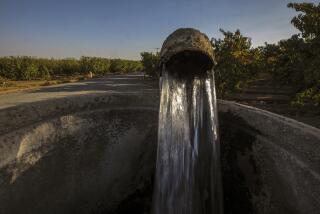How to Combat the Drought Next Time : WATER WATCH: Why California will never be the same
- Share via
As the saying goes, the process is about as exciting as watching dust settle, but it is crucial to sound water management. One technique for managing water supply is recharging aquifers during wet seasons so that water can be pumped from wells in dry years. Basically, surplus water is spread over the surface so that it eventually drips into these underground caverns known as aquifers.
In this and many other tedious ways, bits and pieces of new ideas are being discussed, voted on and negotiated to ensure that the next drought does not catch California napping. In effect, the state is quietly making certain that water policy will never be the same again.
1. In Gov. Pete Wilson’s Administration, water specialists have begun long-range water planning in ways that apparently have not been used before. The first step will be forecasting future demand for water, based on projections of population, land likely to be in production, levels of industrial and commercial activity and other data. The forecasts will be broken up by region so that planners can make educated guesses not just about how much water will be required but where it will have to be delivered.
That done, planners could start identifying sources of the needed water, as well as specific ways to make up for shortages.
2. In another case with landmark potential, Los Angeles is analyzing a proposal to take polluted agricultural land out of production in the San Joaquin Valley and use, for more productive purposes, water that is now pumped into the irrigation ditches in the farming area.
The pollutant is selenium, an element chemically akin to sulfur that shows up in minute quantities in water used for farming in the valley. It is harmless, except in high doses.
In the early 1980s, dead and deformed ducks and other waterfowl were discovered around a wildlife refuge about 100 miles south of Sacramento. Years of runoff from irrigated land near the refuge had boosted selenium concentrations to deadly levels. Worse, polluted water is migrating underground, threatening thousands of new acres of farmland.
Stopping irrigation would return the land to scrub prairie and free thousands of acre-feet of water for shipment to Los Angeles.
What makes the case both a thorny and promising test of new policy is the instinct of farmers in the area to divert the unused water to other farms in the region rather than sending it south.
But environmental groups as well as a few farmers agree that irrigating polluted land should stop. It may take years to work out, but it is the sort of venture that water managers mean when they say five years of drought have assured that California water policy will change.
More to Read
Sign up for Essential California
The most important California stories and recommendations in your inbox every morning.
You may occasionally receive promotional content from the Los Angeles Times.












